In this post you are going to get a step by step breakdown on how to get started playing chord melody guitar – in both a solo jazz guitar context, as well as in a band.
Check out this video for the end result you will be getting out of working through this article on chord melody guitar playing:
Don’t have time to read this post now?
Handy PDF Download: Get access here to download a print-friendly PDF version of this article including all the lead sheets, chord diagrams, backing tracks and instructions.
This is a huge topic of course, and just one article couldn’t possibly cover all the techniques and concepts of chord melody guitar. So, this post will cover the essentials to quickly get you up and running playing jazz guitar, chord melody style. Let’s get started!
So what is Chord Melody Guitar anyway?
Generally, chord melody guitar refers to playing jazz guitar with single line melodies or solos and combining or accompanying with chords. This is opposed to just single line soloing or melody playing, or on the flipside only comping in a band with chords. You actually combine the two at the same time, on one guitar.
Getting into the nitty gritty, the term ‘chord melody’ can actually refer to two similar, but nonetheless distinct styles of jazz guitar playing.
On one hand, chord melody can refer to a guitarist mixing chords and melody on a tune in a band setting, e.g a jazz trio of guitar, bass and drums. In this setting, you need to take care in what chord voicings you apply to the melody and your solos. If you play too many low notes on the 5th and 6th strings it can interfere with the bass player.
On the other hand, chord melody guitar playing can also refer to playing jazz tunes arranged or improvised on solo guitar. This is kind of like playing as a one man band: soloist, comping and bass all in one.
To avoid confusion, let’s refer to the setting in a trio or other lineup as a band chord melody, and playing chord melody on your own as jazz guitar solo chord melody.
Now, let’s work through the 5 steps for an awesome chord melody guitar arrangement. As it is a bit easier on the left hand, let’s start with a band chord melody. Then, I’m going to show you how to adapt this version just a little to make an effective jazz guitar solo chord melody.
Step 1: Pick a suitable tune and learn it inside and out
Although you can turn nearly any tune as a chord melody guitar arrangement, it is helpful to find a chart with a melody that isn’t too fast moving. Bebop tunes in straight eighth notes will be difficult (though not impossible) to arrange. For beginners, ballads or swing/broadway standards should do the trick.
Here is a list of tunes that work well as chord melody guitar arrangements for solo jazz guitar as well as in a band:
- All the Things You Are
- On Green Dolphin Street
- Have You Met Miss Jones
- Alone Together
- Autumn Leaves
- Don’t Get Around Much Anymore
- Fly Me To the Moon
- Georgia on My Mind
- Just Friends
- Moon River
- My Funny Valentine
- Night and Day
For this post, I’ll be using a jazz tune called Rochelle I wrote recently for my darling wife (awwww). Here is the lead sheet to use as a starting point:
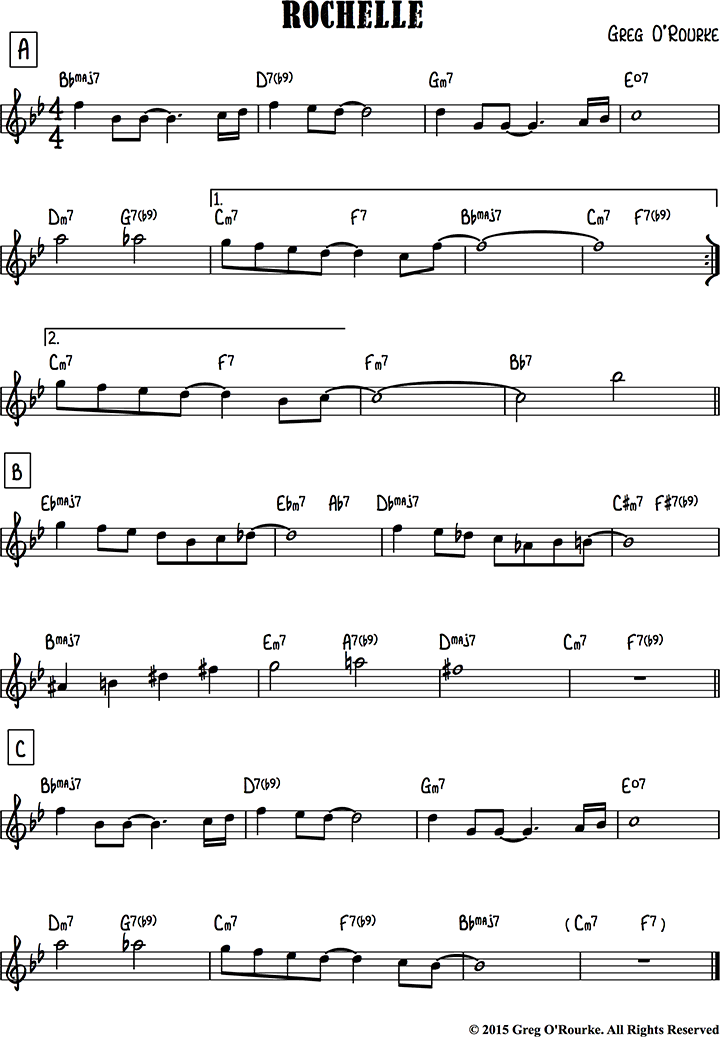
Audio example:
Now that we have found a suitable tune, it’s time to learn it just like you would learn any other jazz standard:
- Learn the melody both on your guitar and singing
- Try comping over the changes
- Improvise over the changes
- Memorize the melody and the chords
Also, listen to recordings and watch youtube videos of others playing the tune. This is a great way to get an ideas for your own arrangement.
Step 2: Transpose to an appropriate key if necessary
Changing the key may be necessary to suit the setting you are playing the arrangement in (i.e. as a solo or in a band), and also can give the arrangement a particular flavour. Some keys work better than others and it’s helpful to consider open strings in the chord voicings if possible as using them can give some great effects.
As I was playing around with this tune in the original key of Bb Major, I noticed that the melody is getting a little bit low in places:
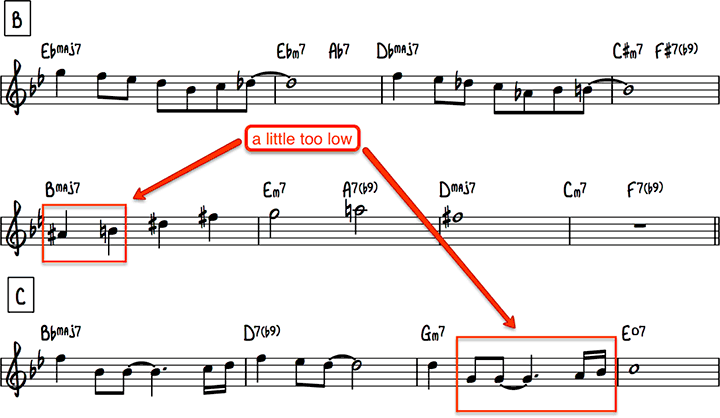
This causes issues for a chord melody arrangement on guitar, as you may be unable to fit good sounding chord voicings underneath the melody. Voicings that low could start to sound muddy and will get in the way of the band’s bass player.
A way to solve this might be to take the melody up an octave, however in this case the tune will be too high on the guitar neck for it to sound good:
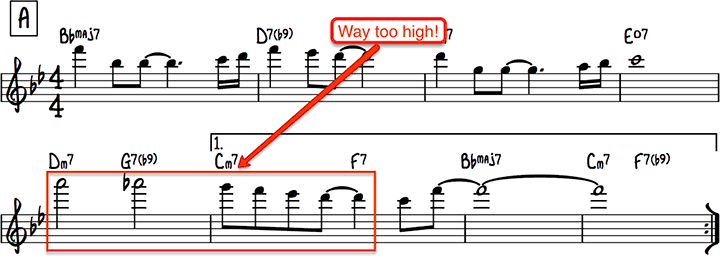
After transposing the lead sheet to F Major, it seems to sit in a much more suitable range for a chord melody guitar arrangement, so let’s work on the tune in this key:
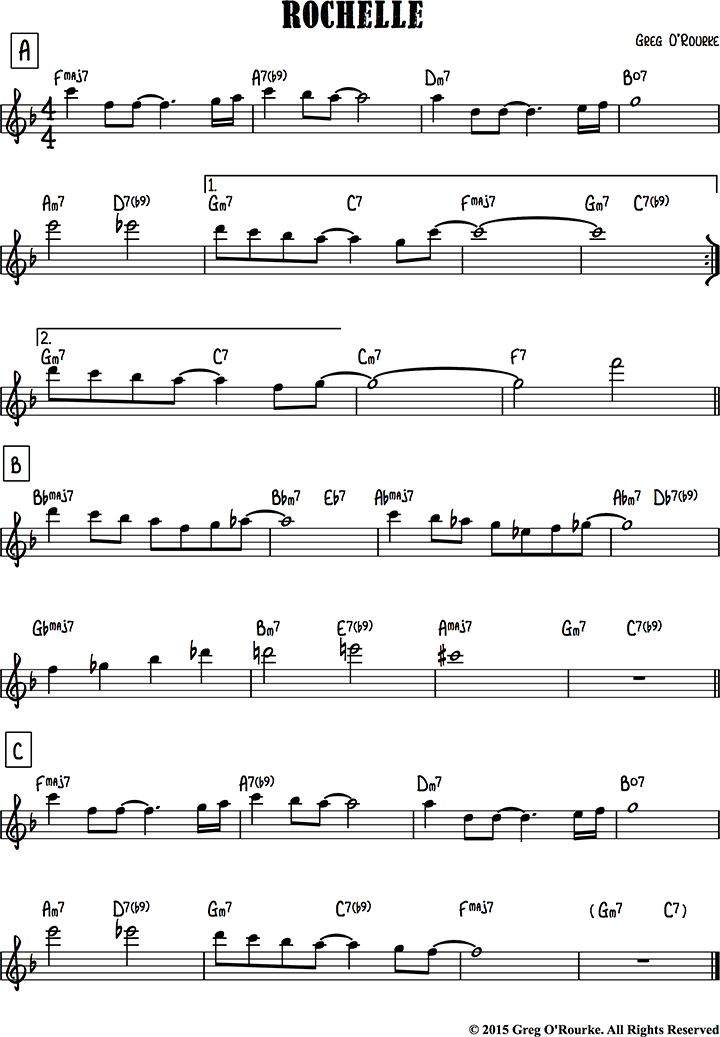
Audio example:
Sometimes transposing the tune can also give the arrangement a distinct sound or colour, so even if a tune already seems to sit well on the guitar it is still worthwhile playing around and experimenting with different keys.
Step 3: Learn the melody on the top 2 strings
Now that you have chosen the key for your arrangement, the next step is to learn the melody on the top 2 strings. This will give you an idea of what chord voicings to apply to the melody that we’ll cover in the next step.
Here is an example of how you could play Rochelle on mainly the top 2 strings. Note that it’s ok to occasionally go to the 3rd string for a passing melody note however make sure you don’t do this too often, as it will start to become difficult to find workable chord voicings.
Video Example:
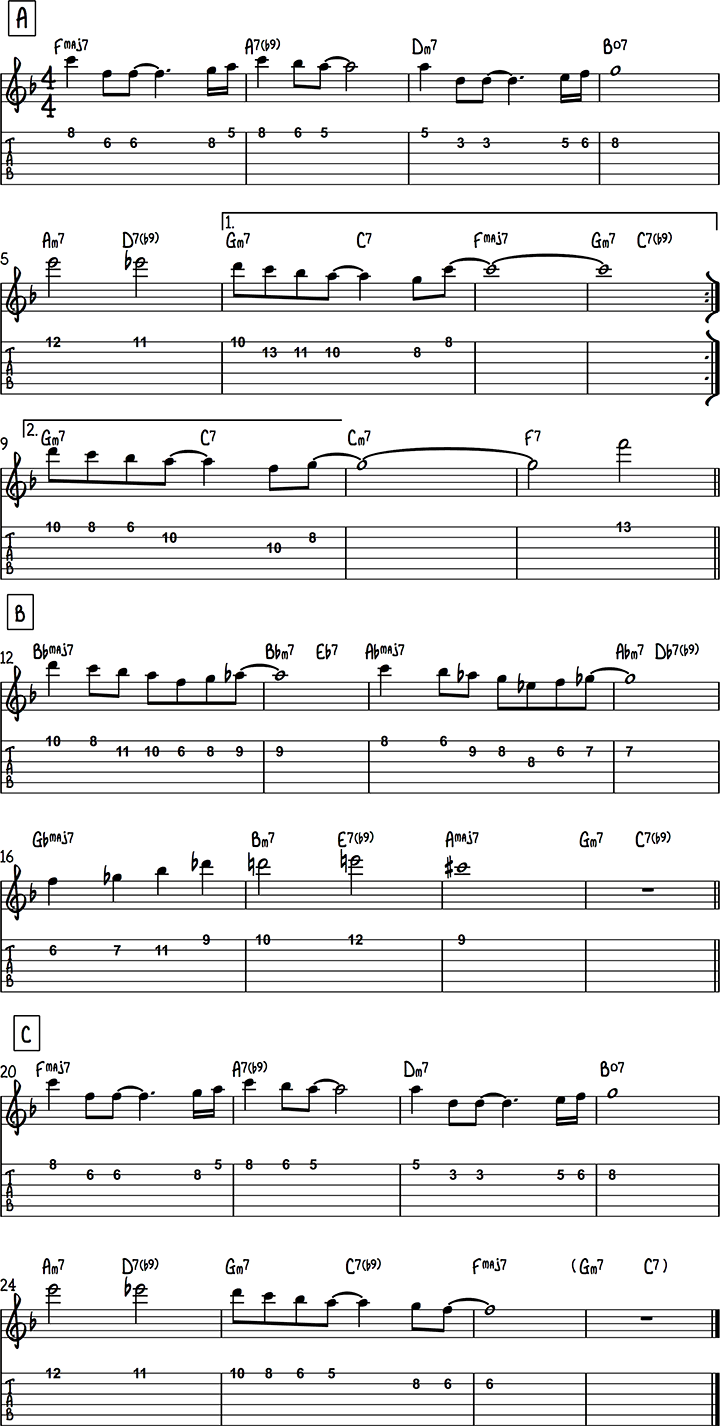
Backing track:
Step 4: Choose chord voicings
You have come to the most important step in the process – applying chord voicings to the melody line that we have practiced on the top 2 strings, to create your very own chord melody guitar arrangement.
You may have been inspired by the genius of Joe Pass or Wes Montgomery and the creative and virtuosic twists and turns of their chord melody arrangements, but let’s not get carried away here.
For now, keep it simple!
This step is a straightforward process of applying a chord to the first melody note of each bar and/or each chord change in the lead sheet.
Let’s play the melody again now on the top 2 strings, but try to image where you would like the chords placed. Generally, placing them on the start of each bar or at chord change usually works well.
Mark out these points on your lead sheet:
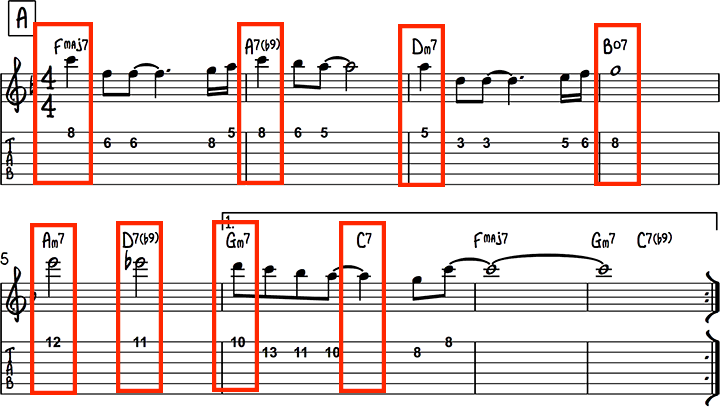
How do I know which chord voicing to use?
Here is the simple trick for easy chord melody arranging:
Choose chord voicings that have the same interval of the melody note as the highest note in the chord shape,
OR
a voicing that can be slightly adapted to have the melody note as the highest note and still sound good.
That sounds great and makes sense, you might be thinking, but do we know the relevant chord shapes. Do we know what variations of the chord to use? How do we remember all the different shapes for the voicings?
The answer is to build your own chord dictionary.
Creating a chord dictionary
A jazz chord melody guitar player is a collector of chords. Whenever you learn an existing chord melody arrangement, or transcribe a chord melody or chord solo, add any voicings you find in a dictionary grouped in main chord types.
I group my dictionary according to major, minor, dominant, altered dominant, half-diminished (i.e. minor 7b5), and diminished.
If you are new to jazz chord theory or unsure how to construct chords, check out this great guide from Jazz Guitar Online (go to the ‘Jazz Guitar Chord Theory’ heading).
Let’s start your chord dictionary with some of my favourite voicings I use for chord melody arranging. Here is a sample of chords from my own dictionary:
Major – e.g. Amaj7
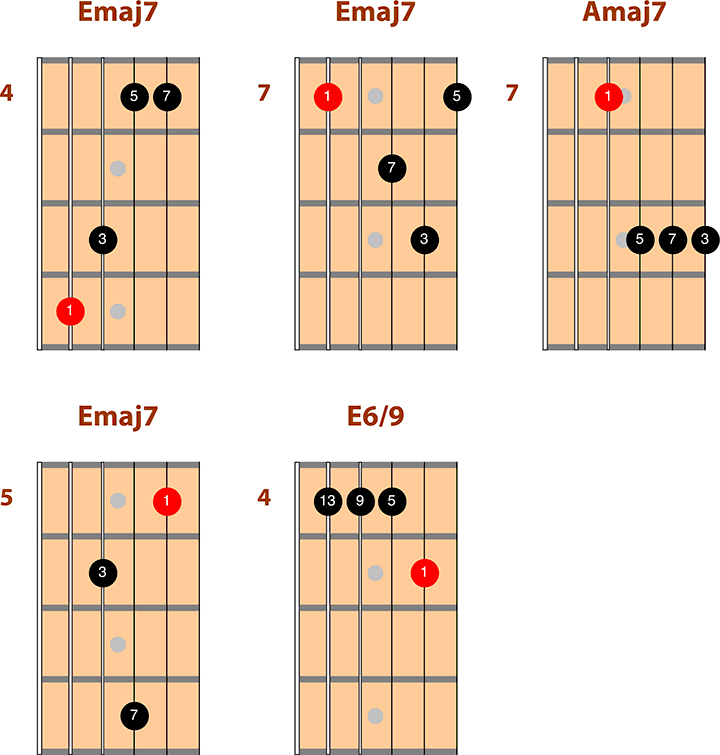
Minor – e.g. Amin7
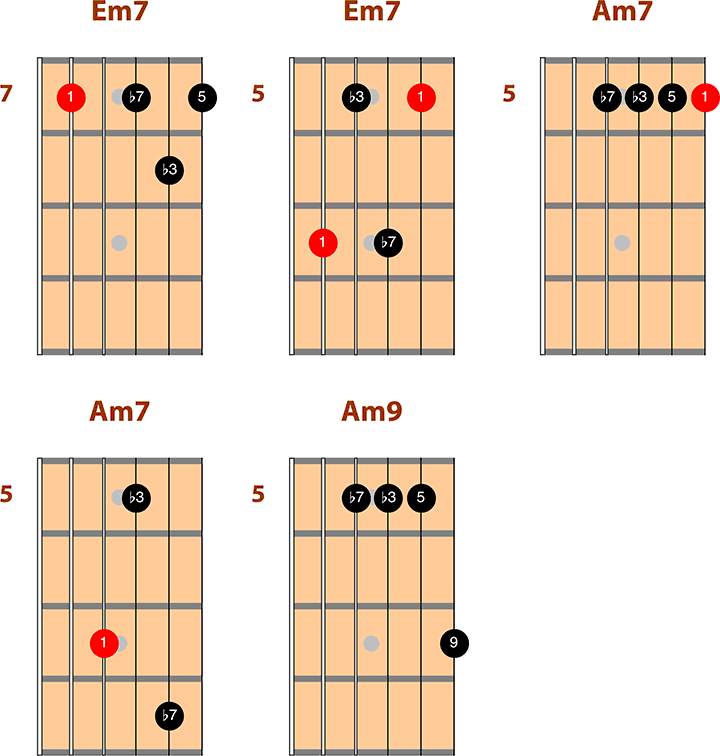
Dominant – e.g. A7
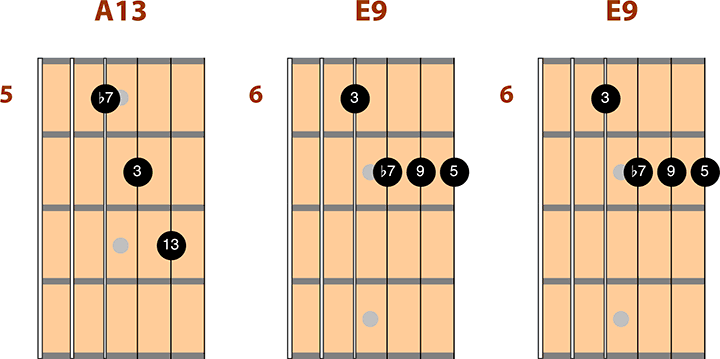
Altered Dominant – eg A7b9
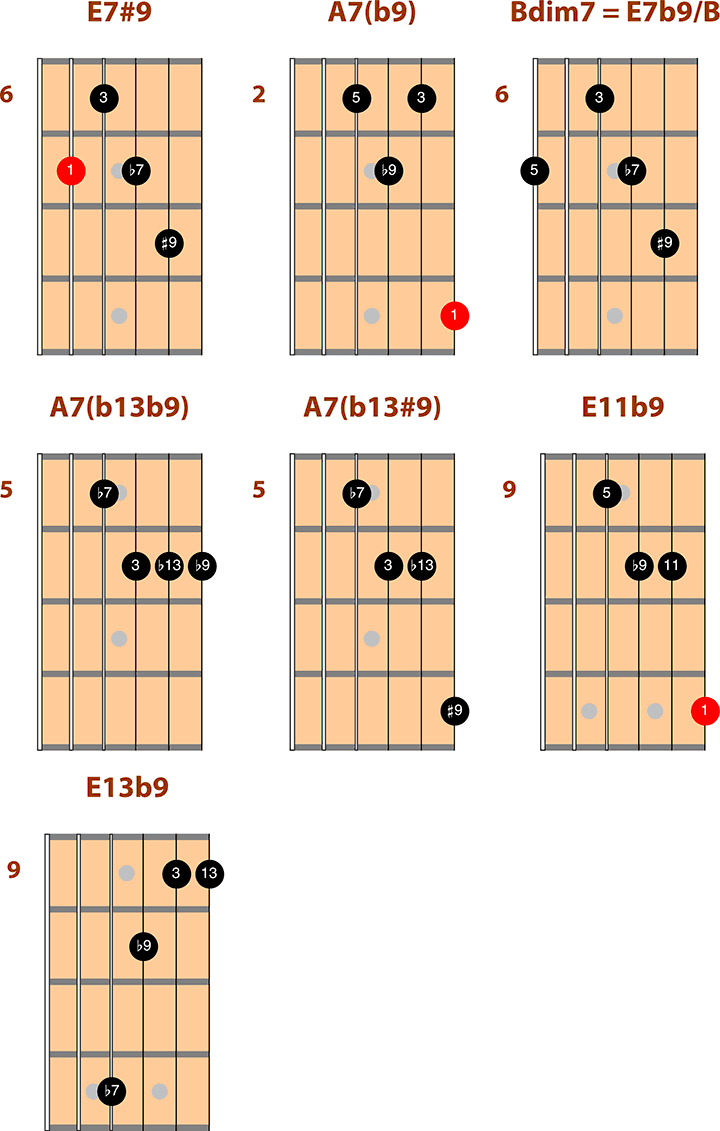
Here’s a few important rules to keep in mind:
- In most cases, you can substitute any chord for another as long as they belong to the same chord type. Eg, if you see Am7 on a lead sheet, you could play an Am7, Am6, Am9, Am11 and it would still sound fine.
- Be careful with dominants and altered dominants – an altered dominant includes altered tensions (eg #9, b13, b9, etc), whilst a dominant excludes any altered tensions and has only natural tensions (eg 9, 13, 11, etc).
- When you see an altered dominant chord on a lead sheet (eg. A7b9) you should only play an altered dominant chord type.
- However – this is where it gets a bit confusing – when you see a dominant chord (e.g. A7) on a lead sheet, often you can play either a dominant chord type OR an altered dominant chord type, depending on the situation.
How many chord voicings do I need to know to make a chord melody guitar arrangement?
A lot of people get stuck at this point, for example, here is a recent comment from one of my email subscribers:
“I’m trying to learn and remember all the chord variations for use in chord melodies. In rock you had 6 to 8 chords in a 12 bar set. Now in jazz there are 30 to 40. I’m freaking out trying to remember them all!”
Don’t fret! The truth is you don’t need to know every possible chord shape to make a great sounding chord melody. As we go through the process below, you’ll see why.
How to apply the chord shapes on the melody
Note that the chords I’ve provided above are mainly on string sets 4 3 2 1 and 5 4 3 2 – hence why we only wanted to keep the melody on the top two strings as the melody note will now become the top note of each chord. The numbers on the dots indicate what interval of the chord each note is.
Now that we have our chord shapes, let’s look at the first 2 bars and see how we could harmonize the melody with the chords.
We’ll start by analysing the melody, relating each melody note to the interval of the chord written above it on the lead sheet:

(By the way, if you are lost at this point and are unsure what the numbers I’ve used mean, check out this great series of articles on chords and intervals – especially lesson two which explains what numbers like ‘9’ mean :)
The first note of the melody is a C, which is a 5th of the chord Fmaj7. As we covered above, the Maj7 chord type belongs to the Major chord family, so…
We need to find a major chord shape with a 5th as the highest note in the chord.
If we look at our chord dictionary, you’ll see that this chord shape has a 5th interval as the highest note:
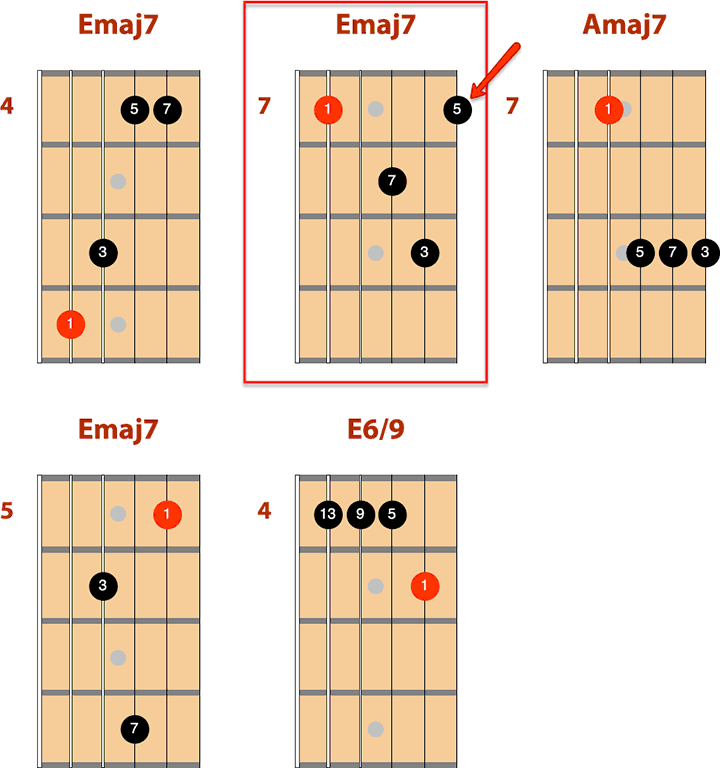
Perfect! Let’s use that chord, but remember to move the shape to the 8th fret, to make it an Fmaj7 (instead of Emaj7 like what’s in the diagram):

Audio example:
In the second bar, we have an A7b9 written on the lead sheet. This chord belongs to the altered dominant chord type, and it looks like the interval is a #9 on top.
Here we go, this pattern has a #9 as the highest interval, so let’s use that one:
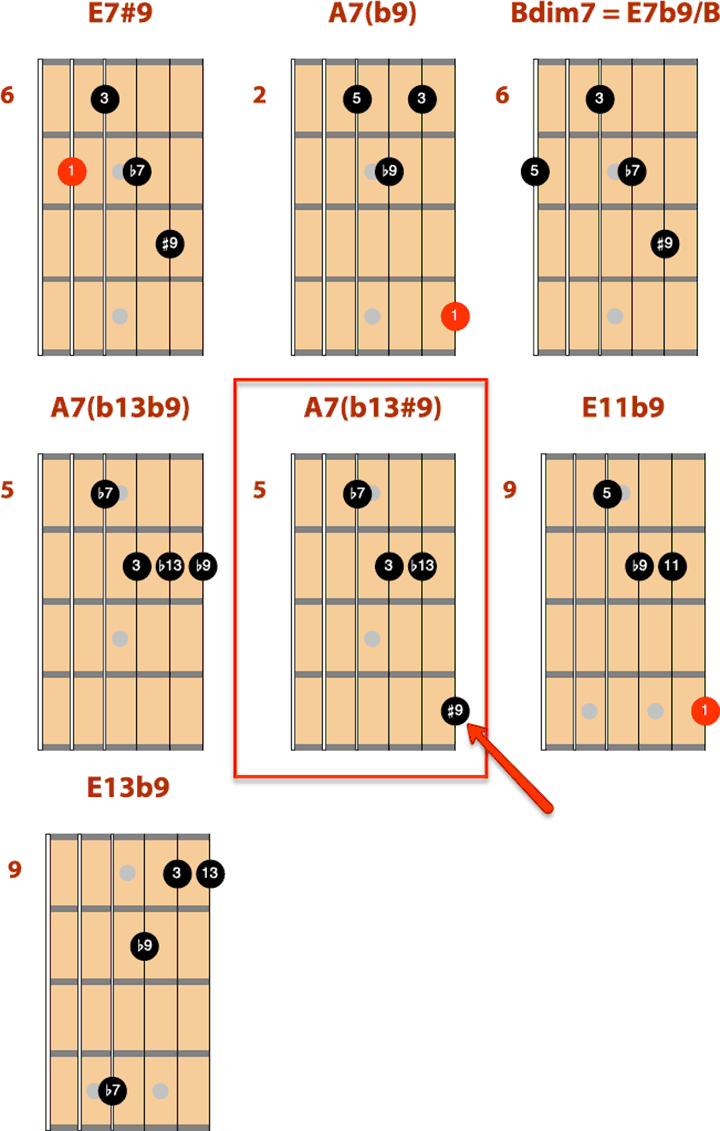

Audio example:
If we add chords to the whole arrangement in this way, using the chord shapes from my dictionary, we’ll get something like this:
Video Example:
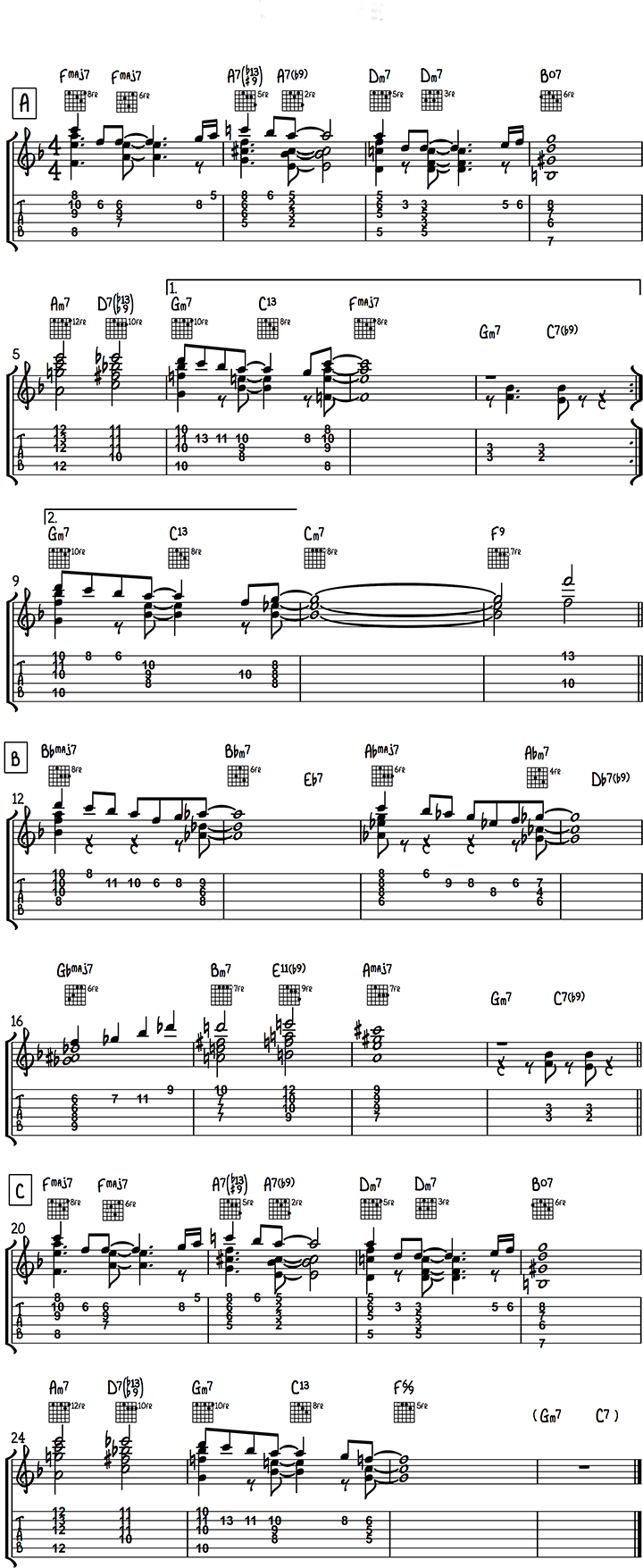
Backing Track:
(Note that some of the chord shapes have been slightly adapted or have had notes omitted so that it has the melody note as the top note).
Don’t be fooled by how complicated the music notation looks. If you look at the TAB and the chord charts, it’s easy to see all I’ve done is added chord voicings from our chord dictionary to the melody line.
As you can see, it’s not necessary to learn very many chord shapes to make a great sounding chord melody arrangement.
Several of the voicings have simply been slid up or down to different places on the fretboard:
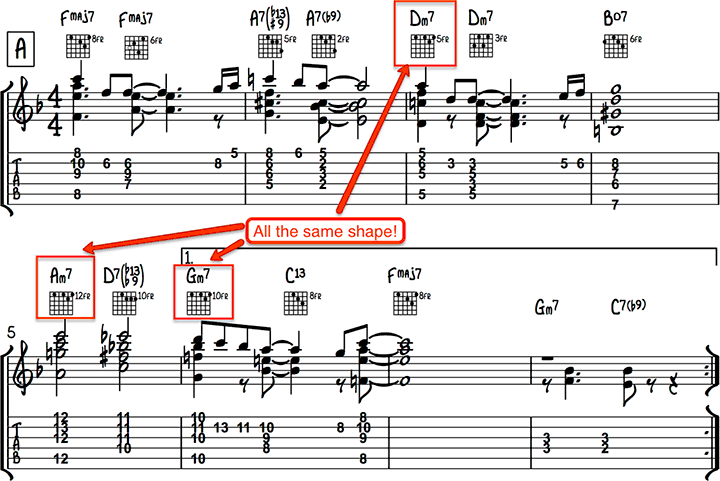
If you are just getting started with chord melody, I would recommend that you start with just stock standard chord voicings. Don’t try to be too clever with the harmony just yet.
Once you learn the arrangement with standard voicings you can then break out of that and do more interesting chord forms and substitutions.
Having said that though, the standard voicings can still sound great – Joe Pass was a master of using standard voicings in very creative ways. To quote martial artist Bruce Lee:
“I fear not the man who has practiced 10,000 kicks once, but I fear the man who has practiced one kick 10,000 times.” – Bruce Lee
Any new chord voicings you learn from transcriptions or other arrangements, remember to take the time to record them in your own chord dictionary so you won’t forget them.
Arranging for Jazz Guitar Solo
In a jazz guitar solo setting we no longer have the band behind us. We’ll need to work a little more on the accompaniment. Although what we have so far sounds great in a band setting, it will sound a bit too sparse for a solo version.
One way to fix this is by using voicings that includes more strings.
Let’s try extending some of our chord voicings by adding lower notes:
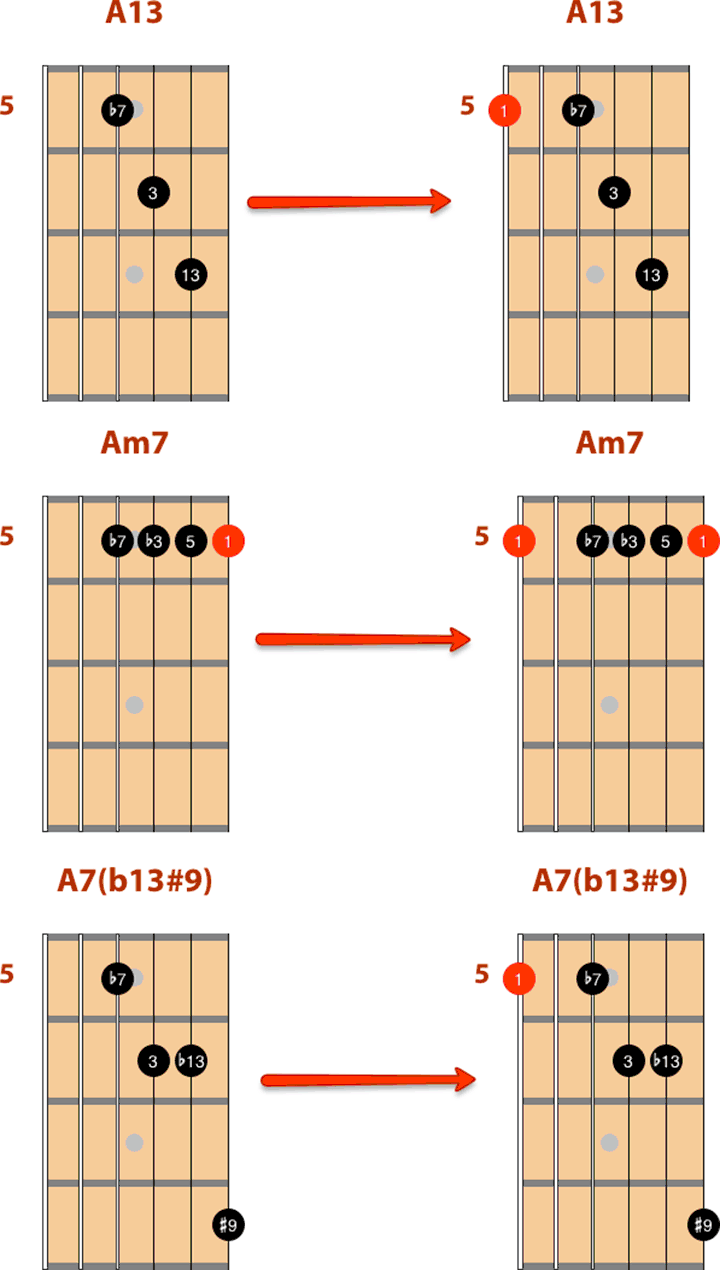
If you now use these ‘thicker’ versions of the chords, and put in a bit of filler comping into the empty bars, you’ll now have a solo guitar version!
Video Example:
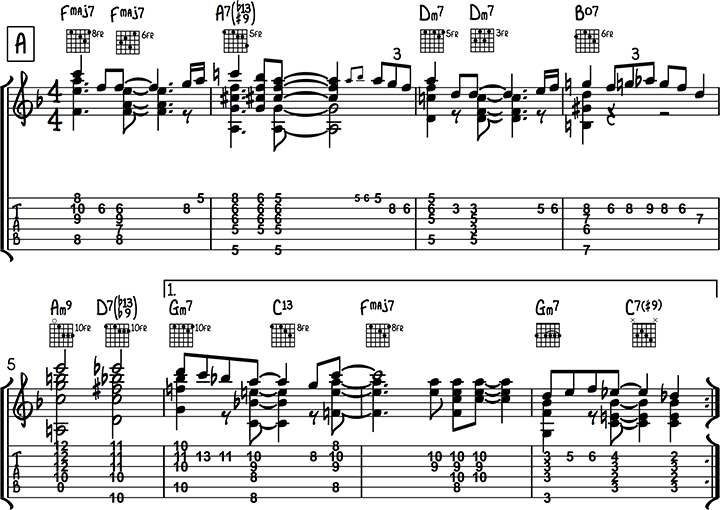
(Note: that the recording isn’t exactly the same as the chart – often I play the bass notes before the rest of the chords for playability, and also add some chromatic bass notes throughout)
You could also do this process in reverse. If you are more familiar with the thicker voicings, try cutting out 1 or two notes in the bottom of the chord to make the voicings more suitable for a band setting – so you don’t get in the way of that pesky bass player…
Step 5: Practise and tweak your arrangement
Taking the time to practise your arrangement will internalise the music in your mind and body, and serves as a good foundation for spontaneously varying your arrangement in a performance.
As you practise, look at ways you can tweak your arrangement to make it easier to play. This is an important step as your arrangement can sound clunky if you are trying to do too much with chords. Remember – less is more.
Through small changes to voicings, omitting unnecessary notes or even complete voicings, you can take a nearly unplayable chord melody guitar arrangement to one that flows and sings really well.
You should arrange for your own technical limitations in mind. If something is easier to play, it will be easier for the audience to listen to as well. You want a chord melody, not a chord malady!
Here are some ways that you can make a chord melody easier on your hands:
- Try different voicings – If you listen to the great guitarist Lenny Breau’s chord melodies, they sound thick and full in the accompaniment. However, if you listen closely he uses mostly only a 3rd and a 7th out of each chord. Experiment with eliminating unessential notes from the chord, as sometimes not only does this make it easier but can also sound much more effective, especially in a band setting.
- Omit difficult notes – even if they are the ‘essential’ notes. Sometimes even if you drop a 3rd or 7th out of a chord, if it’s in a fast moving chord progression the audience will understand the intent of the chord
- Avoid over harmonizing the melody, unless you are going for a chord scale type effect in a phrase. Sometimes just some bass notes under the melody sounds effective. Try to play just the melody only occasionally as it not only is easier but also provides contrast.
Further Resources
Obviously if I was include every aspect of chord melody playing in this post it would go for many more pages than this, however for more resources check out the following:
- Chord Melody Made Easy – video on how to make easy to play chord melody guitar arrangements with 4 simple tricks.
- Chord Chemistry – a fantastic go-to resource on chord melody guitar playing by the late great guitarist Ted Greene
- Speaking of Ted Greene, check out this tribute site featuring many chord melody arrangements you can download in PDF format.
Enjoyed this post on Chord Melody?
Handy PDF Download: Get access here to download a print-friendly PDF version of this article including all the lead sheets, chord diagrams, backing tracks and instructions.
Thanks for reading! I’ll be posting more articles and lessons on this topic in the future, however for now this should be enough to get your teeth stuck into.
Chord melody guitar playing is an excellent way to play jazz on guitar, either in a jazz guitar solo context or in a band, and can open up a whole world of possibilities for you as a guitarist.
Let me know what you think of this article by leaving a comment below. I look forward to hearing your thoughts!
Cheers,
Greg O’Rourke
BMus (Hons), ANU
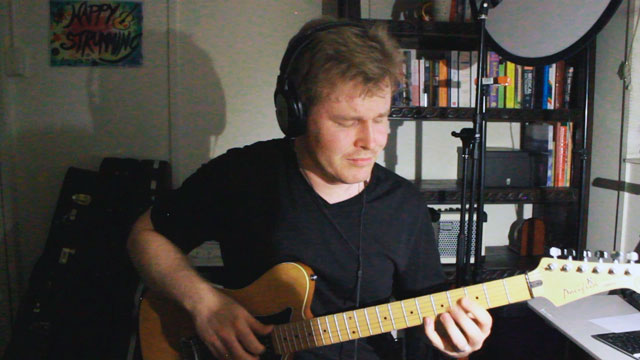
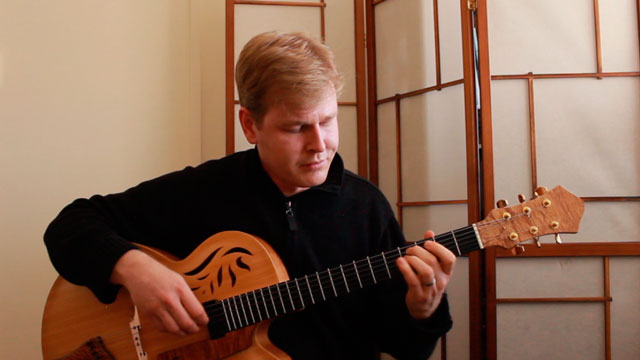
Thanks for this wonderful compendium. I’ve been playing guitar 40 years and have approached really learning jazz a couple of times, always rewarded, but for me, chord melody has always been the Holy Grail. Between your site and Matt Warnock’s, I have hope at giving it another go. Thanks again for this!!
Hi Joe, thanks for reading and glad that you enjoyed this lesson. Best of luck in your chord melody adventures!
This is a cool website u have. I think I’ll visit your website again when u publish some more of the information. Thanks a lot for sharing this information.
Thanks, I’m glad you are enjoying what’s on the site :)
This is such a great starting point for guitarists interested in this style of playing. I wish I had this guide 5 years ago. I’m finding that I already do some of the things you talk about. My excitement grows as I read tips on things that would make it so much easier and sound so much better than the way I currently approach my chord melodies. Thanks for sharing this. I am really enjoying the Facebook group, too.
Thanks Sam, much appreciated :) Likewise enjoying the videos you have posted so far in the Facebook group Sam, great playing!!
Greg, thank you so much! I’ve been trying to figure out how to choose the proper chord voicing for months and your easy and at the same time great article gave me all the answers! You’re the best! Greetings from Russia!
That’s great to hear Konstantin, I’m so glad you found this article helpful.
Great stuff! I’ve been playing guitar since 1960, but even though my harmonic vocabulary is pretty sophisticated, I ‘ve never had the systematic approach that I have in theory and on piano such that I could make it work on guitar. The missing pieces are in this article! The biggest chunks are learning the tune on the top two strings and transposing it into a key where it sounds good on guitar. Thanks a million! I’ll try to get a version of Chelsea Bridge up on your website soon!
Thanks Greg, great lesson.
Nice tune and arrangement I first worked out chord/melody in Bb. F is much better and makes it easier to see that the A section is “Georgia”.
Thanks Greg for the clear and informative chord melody masterclass.
I have the info in my head and understand it.
Now it’s my challenge to get it comfortably under my fingers.
From the sound of the tune you must have an attractive and whimsical wife. Pretty melody.
Love this lesson; very practical & easy to follow. How or where do you create your own chord library? On paper or do you use some sort of software? Thanks.
Hi Randy, Both paper and software are totally doable – it is up to you how you want to organize your collection. There is paid diagram software like “Neck Diagrams” and also free software like “ChordPic”
By the way, you might be interested in the Chord Melody Foundations Course by FretDojo
Check it out!
Have you got any tips for mastering the time counting of tied notes? It seems easy when someone else is playing, as in your audio examples, but it is one thing I struggle with when sight reading and playing at the same time.
Hey Robert, I think practising counting aloud and playing music simultaneously gets easier as we practice doing it. Personally, I like to isolate the skill and practice sight reading rhythms. I count aloud, tapping the rhythm. To change it up I might tap a steady beat and vocalise the rhythm. This kind of drill work can be quite fun and definitely improved my own sight reading on guitar.
Hi Greg
Why do you play a G and not an F in the Bdim7-Chord?
You labeled the intervals for the chord E7b9/B, and write #9. But shouldn’t it be b9? Bdim7 doesn’t have a G, does it?
Hi Gaby. I’m not sure which part you’re talking about but if it’s the g melody note against the Bdim7, yes F would be in the chord while the G would be the b13 tension. It’s also leading to a ii-V-I in G minor so it’s a great leading tone to set that up.